Uday Singh Saini
Empowering Time Series Forecasting with LLM-Agents
Aug 06, 2025Abstract:Large Language Model (LLM) powered agents have emerged as effective planners for Automated Machine Learning (AutoML) systems. While most existing AutoML approaches focus on automating feature engineering and model architecture search, recent studies in time series forecasting suggest that lightweight models can often achieve state-of-the-art performance. This observation led us to explore improving data quality, rather than model architecture, as a potentially fruitful direction for AutoML on time series data. We propose DCATS, a Data-Centric Agent for Time Series. DCATS leverages metadata accompanying time series to clean data while optimizing forecasting performance. We evaluated DCATS using four time series forecasting models on a large-scale traffic volume forecasting dataset. Results demonstrate that DCATS achieves an average 6% error reduction across all tested models and time horizons, highlighting the potential of data-centric approaches in AutoML for time series forecasting.
Towards Efficient Large Scale Spatial-Temporal Time Series Forecasting via Improved Inverted Transformers
Mar 13, 2025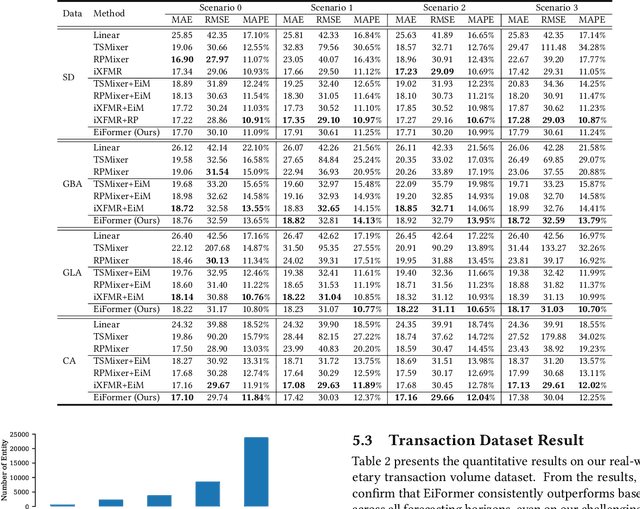

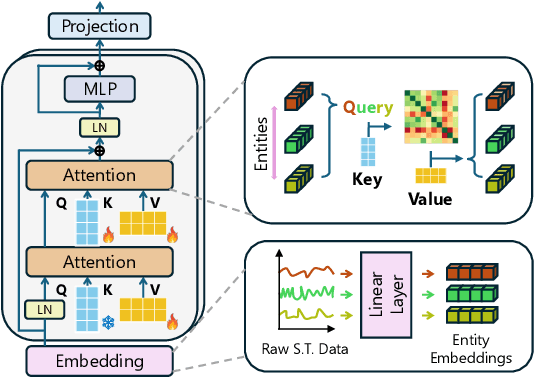
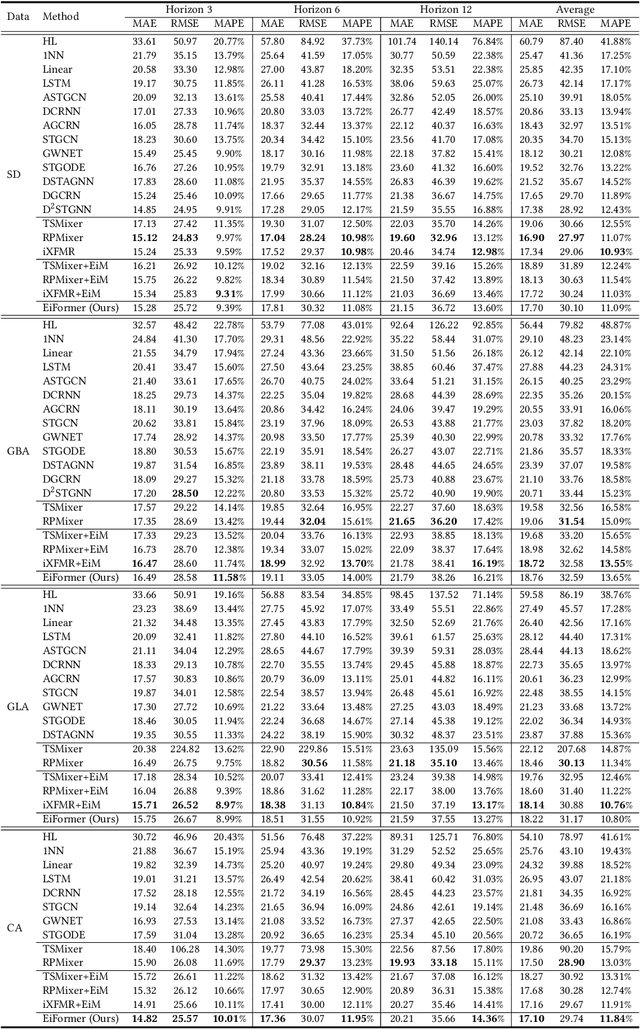
Abstract:Time series forecasting at scale presents significant challenges for modern prediction systems, particularly when dealing with large sets of synchronized series, such as in a global payment network. In such systems, three key challenges must be overcome for accurate and scalable predictions: 1) emergence of new entities, 2) disappearance of existing entities, and 3) the large number of entities present in the data. The recently proposed Inverted Transformer (iTransformer) architecture has shown promising results by effectively handling variable entities. However, its practical application in large-scale settings is limited by quadratic time and space complexity ($O(N^2)$) with respect to the number of entities $N$. In this paper, we introduce EiFormer, an improved inverted transformer architecture that maintains the adaptive capabilities of iTransformer while reducing computational complexity to linear scale ($O(N)$). Our key innovation lies in restructuring the attention mechanism to eliminate redundant computations without sacrificing model expressiveness. Additionally, we incorporate a random projection mechanism that not only enhances efficiency but also improves prediction accuracy through better feature representation. Extensive experiments on the public LargeST benchmark dataset and a proprietary large-scale time series dataset demonstrate that EiFormer significantly outperforms existing methods in both computational efficiency and forecasting accuracy. Our approach enables practical deployment of transformer-based forecasting in industrial applications where handling time series at scale is essential.
Visual Attention Exploration in Vision-Based Mamba Models
Feb 28, 2025
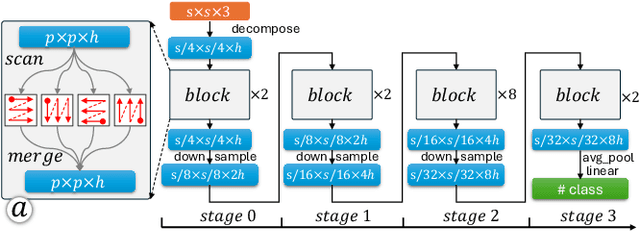
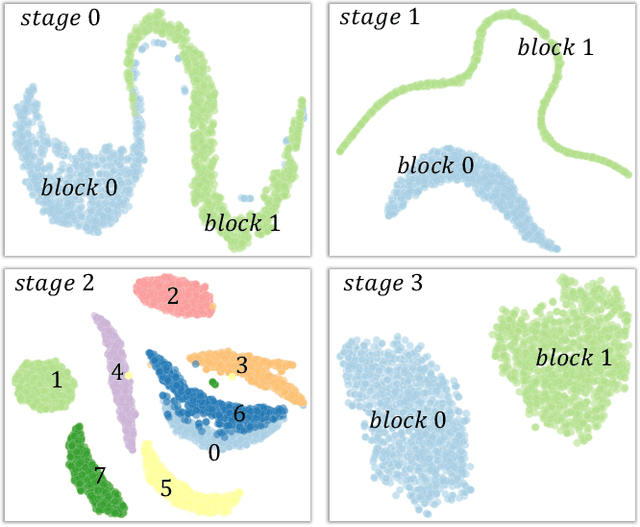

Abstract:State space models (SSMs) have emerged as an efficient alternative to transformer-based models, offering linear complexity that scales better than transformers. One of the latest advances in SSMs, Mamba, introduces a selective scan mechanism that assigns trainable weights to input tokens, effectively mimicking the attention mechanism. Mamba has also been successfully extended to the vision domain by decomposing 2D images into smaller patches and arranging them as 1D sequences. However, it remains unclear how these patches interact with (or attend to) each other in relation to their original 2D spatial location. Additionally, the order used to arrange the patches into a sequence also significantly impacts their attention distribution. To better understand the attention between patches and explore the attention patterns, we introduce a visual analytics tool specifically designed for vision-based Mamba models. This tool enables a deeper understanding of how attention is distributed across patches in different Mamba blocks and how it evolves throughout a Mamba model. Using the tool, we also investigate the impact of different patch-ordering strategies on the learned attention, offering further insights into the model's behavior.
A Compact Model for Large-Scale Time Series Forecasting
Feb 28, 2025



Abstract:Spatio-temporal data, which commonly arise in real-world applications such as traffic monitoring, financial transactions, and ride-share demands, represent a special category of multivariate time series. They exhibit two distinct characteristics: high dimensionality and commensurability across spatial locations. These attributes call for computationally efficient modeling approaches and facilitate the use of univariate forecasting models in a channel-independent fashion. SparseTSF, a recently introduced competitive univariate forecasting model, harnesses periodicity to achieve compactness by concentrating on cross-period dynamics, thereby extending the Pareto frontier with respect to model size and predictive performance. Nonetheless, it underperforms on spatio-temporal data due to an inadequate capture of intra-period temporal dependencies. To address this shortcoming, we propose UltraSTF, which integrates a cross-period forecasting module with an ultra-compact shape bank component. Our model effectively detects recurring patterns in time series through the attention mechanism of the shape bank component, thereby strengthening its ability to learn intra-period dynamics. UltraSTF achieves state-of-the-art performance on the LargeST benchmark while employing fewer than 0.2% of the parameters required by the second-best approaches, thus further extending the Pareto frontier of existing methods.
Matrix Profile for Anomaly Detection on Multidimensional Time Series
Sep 14, 2024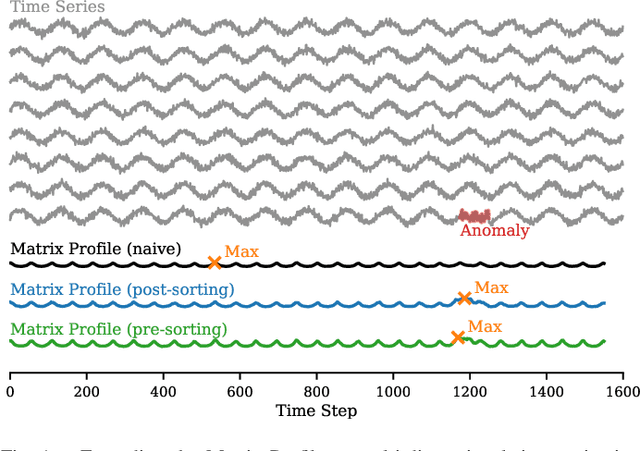
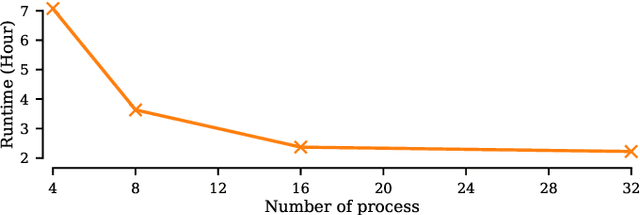
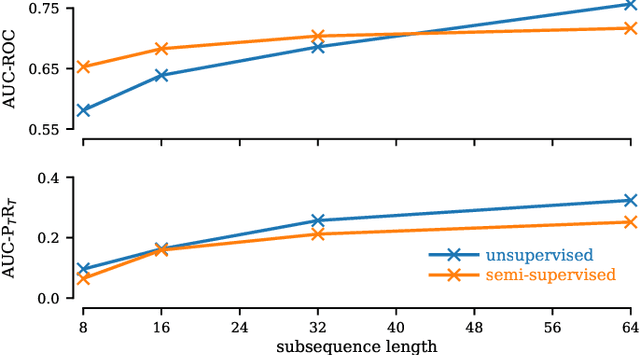
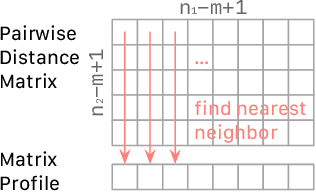
Abstract:The Matrix Profile (MP), a versatile tool for time series data mining, has been shown effective in time series anomaly detection (TSAD). This paper delves into the problem of anomaly detection in multidimensional time series, a common occurrence in real-world applications. For instance, in a manufacturing factory, multiple sensors installed across the site collect time-varying data for analysis. The Matrix Profile, named for its role in profiling the matrix storing pairwise distance between subsequences of univariate time series, becomes complex in multidimensional scenarios. If the input univariate time series has n subsequences, the pairwise distance matrix is a n x n matrix. In a multidimensional time series with d dimensions, the pairwise distance information must be stored in a n x n x d tensor. In this paper, we first analyze different strategies for condensing this tensor into a profile vector. We then investigate the potential of extending the MP to efficiently find k-nearest neighbors for anomaly detection. Finally, we benchmark the multidimensional MP against 19 baseline methods on 119 multidimensional TSAD datasets. The experiments covers three learning setups: unsupervised, supervised, and semi-supervised. MP is the only method that consistently delivers high performance across all setups.
Preserving Individuality while Following the Crowd: Understanding the Role of User Taste and Crowd Wisdom in Online Product Rating Prediction
Sep 06, 2024



Abstract:Numerous algorithms have been developed for online product rating prediction, but the specific influence of user and product information in determining the final prediction score remains largely unexplored. Existing research often relies on narrowly defined data settings, which overlooks real-world challenges such as the cold-start problem, cross-category information utilization, and scalability and deployment issues. To delve deeper into these aspects, and particularly to uncover the roles of individual user taste and collective wisdom, we propose a unique and practical approach that emphasizes historical ratings at both the user and product levels, encapsulated using a continuously updated dynamic tree representation. This representation effectively captures the temporal dynamics of users and products, leverages user information across product categories, and provides a natural solution to the cold-start problem. Furthermore, we have developed an efficient data processing strategy that makes this approach highly scalable and easily deployable. Comprehensive experiments in real industry settings demonstrate the effectiveness of our approach. Notably, our findings reveal that individual taste dominates over collective wisdom in online product rating prediction, a perspective that contrasts with the commonly observed wisdom of the crowd phenomenon in other domains. This dominance of individual user taste is consistent across various model types, including the boosting tree model, recurrent neural network (RNN), and transformer-based architectures. This observation holds true across the overall population, within individual product categories, and in cold-start scenarios. Our findings underscore the significance of individual user tastes in the context of online product rating prediction and the robustness of our approach across different model architectures.
Has Your Pretrained Model Improved? A Multi-head Posterior Based Approach
Jan 15, 2024



Abstract:The emergence of pretrained models has significantly impacted Natural Language Processing (NLP) and Computer Vision to relational datasets. Traditionally, these models are assessed through fine-tuned downstream tasks. However, this raises the question of how to evaluate these models more efficiently and more effectively. In this study, we explore a novel approach where we leverage the meta features associated with each entity as a source of worldly knowledge and employ entity representations from the models. We propose using the consistency between these representations and the meta features as a metric for evaluating pretrained models. Our method's effectiveness is demonstrated across various domains, including models with relational datasets, large language models and image models.
CARL-G: Clustering-Accelerated Representation Learning on Graphs
Jun 12, 2023
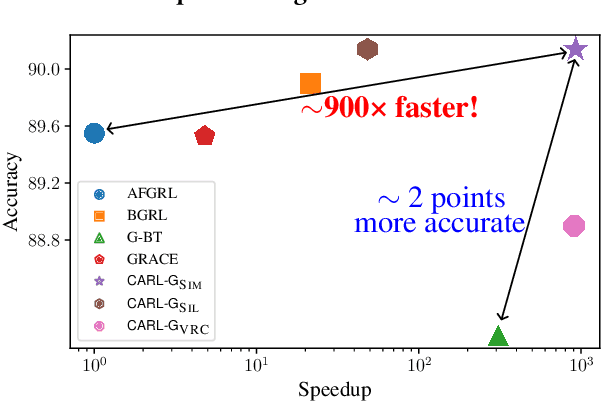
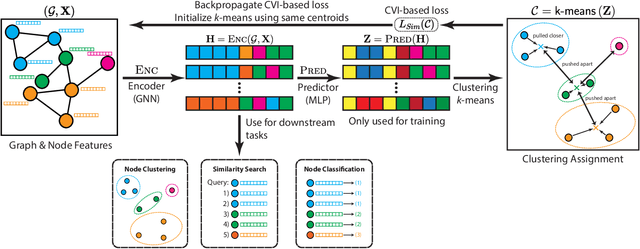
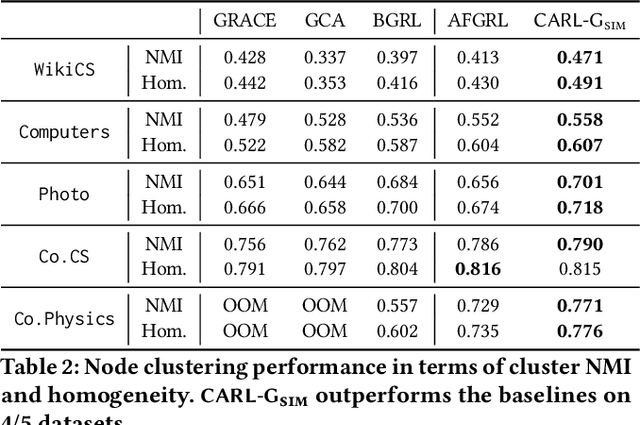
Abstract:Self-supervised learning on graphs has made large strides in achieving great performance in various downstream tasks. However, many state-of-the-art methods suffer from a number of impediments, which prevent them from realizing their full potential. For instance, contrastive methods typically require negative sampling, which is often computationally costly. While non-contrastive methods avoid this expensive step, most existing methods either rely on overly complex architectures or dataset-specific augmentations. In this paper, we ask: Can we borrow from classical unsupervised machine learning literature in order to overcome those obstacles? Guided by our key insight that the goal of distance-based clustering closely resembles that of contrastive learning: both attempt to pull representations of similar items together and dissimilar items apart. As a result, we propose CARL-G - a novel clustering-based framework for graph representation learning that uses a loss inspired by Cluster Validation Indices (CVIs), i.e., internal measures of cluster quality (no ground truth required). CARL-G is adaptable to different clustering methods and CVIs, and we show that with the right choice of clustering method and CVI, CARL-G outperforms node classification baselines on 4/5 datasets with up to a 79x training speedup compared to the best-performing baseline. CARL-G also performs at par or better than baselines in node clustering and similarity search tasks, training up to 1,500x faster than the best-performing baseline. Finally, we also provide theoretical foundations for the use of CVI-inspired losses in graph representation learning.
Subspace Clustering Based Analysis of Neural Networks
Jul 02, 2021



Abstract:Tools to analyze the latent space of deep neural networks provide a step towards better understanding them. In this work, we motivate sparse subspace clustering (SSC) with an aim to learn affinity graphs from the latent structure of a given neural network layer trained over a set of inputs. We then use tools from Community Detection to quantify structures present in the input. These experiments reveal that as we go deeper in a network, inputs tend to have an increasing affinity to other inputs of the same class. Subsequently, we utilise matrix similarity measures to perform layer-wise comparisons between affinity graphs. In doing so we first demonstrate that when comparing a given layer currently under training to its final state, the shallower the layer of the network, the quicker it is to converge than the deeper layers. When performing a pairwise analysis of the entire network architecture, we observe that, as the network increases in size, it reorganises from a state where each layer is moderately similar to its neighbours, to a state where layers within a block have high similarity than to layers in other blocks. Finally, we analyze the learned affinity graphs of the final convolutional layer of the network and demonstrate how an input's local neighbourhood affects its classification by the network.
Analyzing Representations inside Convolutional Neural Networks
Dec 23, 2020
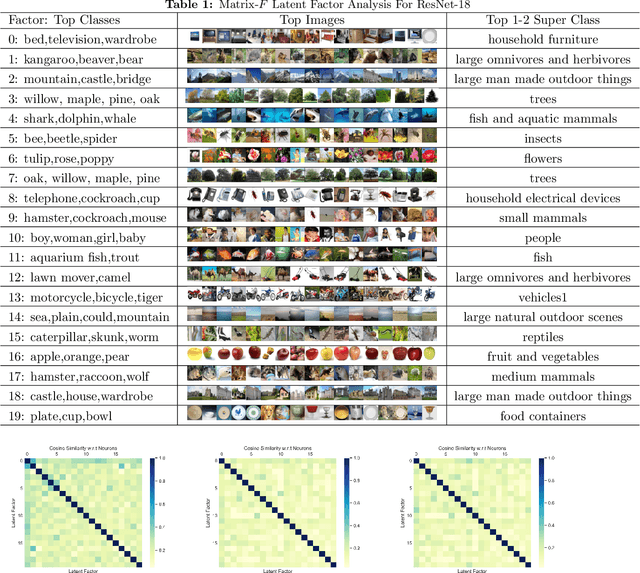
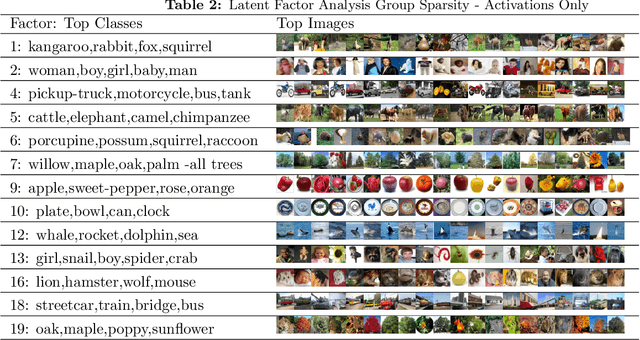

Abstract:How can we discover and succinctly summarize the concepts that a neural network has learned? Such a task is of great importance in applications of networks in areas of inference that involve classification, like medical diagnosis based on fMRI/x-ray etc. In this work, we propose a framework to categorize the concepts a network learns based on the way it clusters a set of input examples, clusters neurons based on the examples they activate for, and input features all in the same latent space. This framework is unsupervised and can work without any labels for input features, it only needs access to internal activations of the network for each input example, thereby making it widely applicable. We extensively evaluate the proposed method and demonstrate that it produces human-understandable and coherent concepts that a ResNet-18 has learned on the CIFAR-100 dataset.
 Add to Chrome
Add to Chrome Add to Firefox
Add to Firefox Add to Edge
Add to Edge